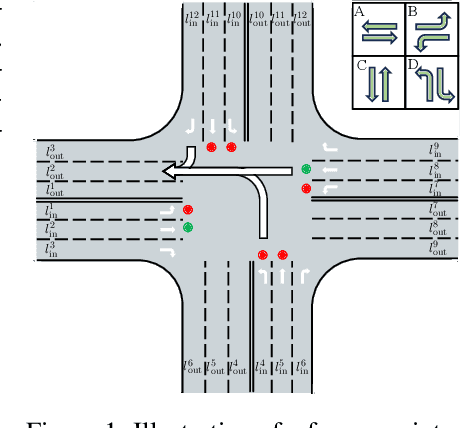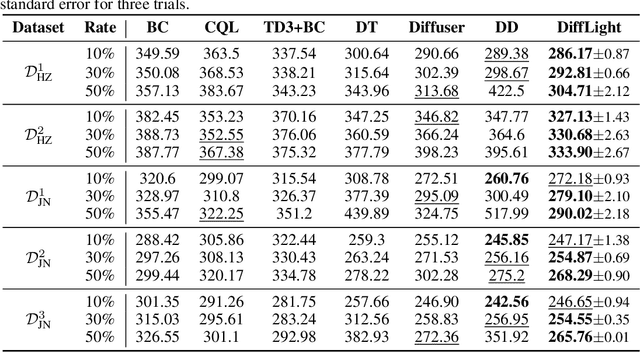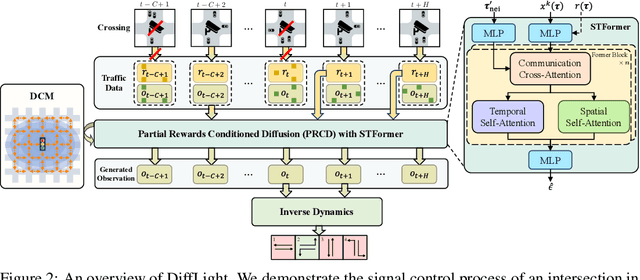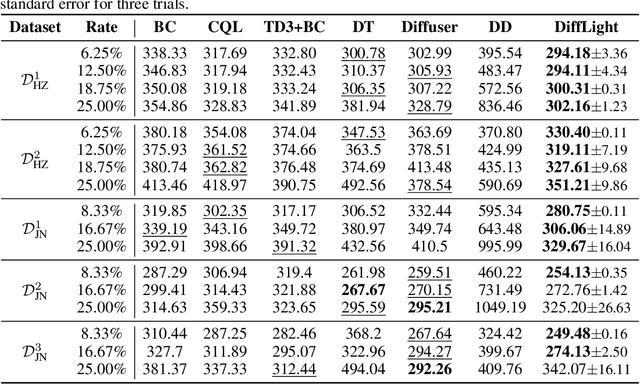Shengnan Guo
Towards An Efficient and Effective En Route Travel Time Estimation Framework
Apr 05, 2025Abstract:En route travel time estimation (ER-TTE) focuses on predicting the travel time of the remaining route. Existing ER-TTE methods always make re-estimation which significantly hinders real-time performance, especially when faced with the computational demands of simultaneous user requests. This results in delays and reduced responsiveness in ER-TTE services. We propose a general efficient framework U-ERTTE combining an Uncertainty-Guided Decision mechanism (UGD) and Fine-Tuning with Meta-Learning (FTML) to address these challenges. UGD quantifies the uncertainty and provides confidence intervals for the entire route. It selectively re-estimates only when the actual travel time deviates from the predicted confidence intervals, thereby optimizing the efficiency of ER-TTE. To ensure the accuracy of confidence intervals and accurate predictions that need to re-estimate, FTML is employed to train the model, enabling it to learn general driving patterns and specific features to adapt to specific tasks. Extensive experiments on two large-scale real datasets demonstrate that the U-ERTTE framework significantly enhances inference speed and throughput while maintaining high effectiveness. Our code is available at https://github.com/shenzekai/U-ERTTE
An Experimental Evaluation of Imputation Models for Spatial-Temporal Traffic Data
Dec 06, 2024



Abstract:Traffic data imputation is a critical preprocessing step in intelligent transportation systems, enabling advanced transportation services. Despite significant advancements in this field, selecting the most suitable model for practical applications remains challenging due to three key issues: 1) incomprehensive consideration of missing patterns that describe how data loss along spatial and temporal dimensions, 2) the lack of test on standardized datasets, and 3) insufficient evaluations. To this end, we first propose practice-oriented taxonomies for missing patterns and imputation models, systematically identifying all possible forms of real-world traffic data loss and analyzing the characteristics of existing models. Furthermore, we introduce a unified benchmarking pipeline to comprehensively evaluate 10 representative models across various missing patterns and rates. This work aims to provide a holistic understanding of traffic data imputation research and serve as a practical guideline.
DiffLight: A Partial Rewards Conditioned Diffusion Model for Traffic Signal Control with Missing Data
Oct 31, 2024



Abstract:The application of reinforcement learning in traffic signal control (TSC) has been extensively researched and yielded notable achievements. However, most existing works for TSC assume that traffic data from all surrounding intersections is fully and continuously available through sensors. In real-world applications, this assumption often fails due to sensor malfunctions or data loss, making TSC with missing data a critical challenge. To meet the needs of practical applications, we introduce DiffLight, a novel conditional diffusion model for TSC under data-missing scenarios in the offline setting. Specifically, we integrate two essential sub-tasks, i.e., traffic data imputation and decision-making, by leveraging a Partial Rewards Conditioned Diffusion (PRCD) model to prevent missing rewards from interfering with the learning process. Meanwhile, to effectively capture the spatial-temporal dependencies among intersections, we design a Spatial-Temporal transFormer (STFormer) architecture. In addition, we propose a Diffusion Communication Mechanism (DCM) to promote better communication and control performance under data-missing scenarios. Extensive experiments on five datasets with various data-missing scenarios demonstrate that DiffLight is an effective controller to address TSC with missing data. The code of DiffLight is released at https://github.com/lokol5579/DiffLight-release.
Mobility-LLM: Learning Visiting Intentions and Travel Preferences from Human Mobility Data with Large Language Models
Oct 29, 2024



Abstract:Location-based services (LBS) have accumulated extensive human mobility data on diverse behaviors through check-in sequences. These sequences offer valuable insights into users' intentions and preferences. Yet, existing models analyzing check-in sequences fail to consider the semantics contained in these sequences, which closely reflect human visiting intentions and travel preferences, leading to an incomplete comprehension. Drawing inspiration from the exceptional semantic understanding and contextual information processing capabilities of large language models (LLMs) across various domains, we present Mobility-LLM, a novel framework that leverages LLMs to analyze check-in sequences for multiple tasks. Since LLMs cannot directly interpret check-ins, we reprogram these sequences to help LLMs comprehensively understand the semantics of human visiting intentions and travel preferences. Specifically, we introduce a visiting intention memory network (VIMN) to capture the visiting intentions at each record, along with a shared pool of human travel preference prompts (HTPP) to guide the LLM in understanding users' travel preferences. These components enhance the model's ability to extract and leverage semantic information from human mobility data effectively. Extensive experiments on four benchmark datasets and three downstream tasks demonstrate that our approach significantly outperforms existing models, underscoring the effectiveness of Mobility-LLM in advancing our understanding of human mobility data within LBS contexts.
PTR: A Pre-trained Language Model for Trajectory Recovery
Oct 18, 2024Abstract:Spatiotemporal trajectory data is vital for web-of-things services and is extensively collected and analyzed by web-based hardware and platforms. However, issues such as service interruptions and network instability often lead to sparsely recorded trajectories, resulting in a loss of detailed movement data. As a result, recovering these trajectories to restore missing information becomes essential. Despite progress, several challenges remain unresolved. First, the lack of large-scale dense trajectory data hampers the performance of existing deep learning methods, which rely heavily on abundant data for supervised training. Second, current methods struggle to generalize across sparse trajectories with varying sampling intervals, necessitating separate re-training for each interval and increasing computational costs. Third, external factors crucial for the recovery of missing points are not fully incorporated. To address these challenges, we propose a framework called PTR. This framework mitigates the issue of limited dense trajectory data by leveraging the capabilities of pre-trained language models (PLMs). PTR incorporates an explicit trajectory prompt and is trained on datasets with multiple sampling intervals, enabling it to generalize effectively across different intervals in sparse trajectories. To capture external factors, we introduce an implicit trajectory prompt that models road conditions, providing richer information for recovering missing points. Additionally, we present a trajectory embedder that encodes trajectory points and transforms the embeddings of both observed and missing points into a format comprehensible to PLMs. Experimental results on two public trajectory datasets with three sampling intervals demonstrate the efficacy and scalability of PTR.
DutyTTE: Deciphering Uncertainty in Origin-Destination Travel Time Estimation
Aug 23, 2024Abstract:Uncertainty quantification in travel time estimation (TTE) aims to estimate the confidence interval for travel time, given the origin (O), destination (D), and departure time (T). Accurately quantifying this uncertainty requires generating the most likely path and assessing travel time uncertainty along the path. This involves two main challenges: 1) Predicting a path that aligns with the ground truth, and 2) modeling the impact of travel time in each segment on overall uncertainty under varying conditions. We propose DutyTTE to address these challenges. For the first challenge, we introduce a deep reinforcement learning method to improve alignment between the predicted path and the ground truth, providing more accurate travel time information from road segments to improve TTE. For the second challenge, we propose a mixture of experts guided uncertainty quantification mechanism to better capture travel time uncertainty for each segment under varying contexts. Additionally, we calibrate our results using Hoeffding's upper-confidence bound to provide statistical guarantees for the estimated confidence intervals. Extensive experiments on two real-world datasets demonstrate the superiority of our proposed method.
PTrajM: Efficient and Semantic-rich Trajectory Learning with Pretrained Trajectory-Mamba
Aug 09, 2024



Abstract:Vehicle trajectories provide crucial movement information for various real-world applications. To better utilize vehicle trajectories, it is essential to develop a trajectory learning approach that can effectively and efficiently extract rich semantic information, including movement behavior and travel purposes, to support accurate downstream applications. However, creating such an approach presents two significant challenges. First, movement behavior are inherently spatio-temporally continuous, making them difficult to extract efficiently from irregular and discrete trajectory points. Second, travel purposes are related to the functionalities of areas and road segments traversed by vehicles. These functionalities are not available from the raw spatio-temporal trajectory features and are hard to extract directly from complex textual features associated with these areas and road segments. To address these challenges, we propose PTrajM, a novel method capable of efficient and semantic-rich vehicle trajectory learning. To support efficient modeling of movement behavior, we introduce Trajectory-Mamba as the learnable model of PTrajM, which effectively extracts continuous movement behavior while being more computationally efficient than existing structures. To facilitate efficient extraction of travel purposes, we propose a travel purpose-aware pre-training procedure, which enables PTrajM to discern the travel purposes of trajectories without additional computational resources during its embedding process. Extensive experiments on two real-world datasets and comparisons with several state-of-the-art trajectory learning methods demonstrate the effectiveness of PTrajM. Code is available at https://anonymous.4open.science/r/PTrajM-C973.
Spatial-Temporal Cross-View Contrastive Pre-training for Check-in Sequence Representation Learning
Jul 25, 2024



Abstract:The rapid growth of location-based services (LBS) has yielded massive amounts of data on human mobility. Effectively extracting meaningful representations for user-generated check-in sequences is pivotal for facilitating various downstream services. However, the user-generated check-in data are simultaneously influenced by the surrounding objective circumstances and the user's subjective intention. Specifically, the temporal uncertainty and spatial diversity exhibited in check-in data make it difficult to capture the macroscopic spatial-temporal patterns of users and to understand the semantics of user mobility activities. Furthermore, the distinct characteristics of the temporal and spatial information in check-in sequences call for an effective fusion method to incorporate these two types of information. In this paper, we propose a novel Spatial-Temporal Cross-view Contrastive Representation (STCCR) framework for check-in sequence representation learning. Specifically, STCCR addresses the above challenges by employing self-supervision from "spatial topic" and "temporal intention" views, facilitating effective fusion of spatial and temporal information at the semantic level. Besides, STCCR leverages contrastive clustering to uncover users' shared spatial topics from diverse mobility activities, while employing angular momentum contrast to mitigate the impact of temporal uncertainty and noise. We extensively evaluate STCCR on three real-world datasets and demonstrate its superior performance across three downstream tasks.
UniTE: A Survey and Unified Pipeline for Pre-training ST Trajectory Embeddings
Jul 17, 2024



Abstract:Spatio-temporal (ST) trajectories are sequences of timestamped locations, which enable a variety of analyses that in turn enable important real-world applications. It is common to map trajectories to vectors, called embeddings, before subsequent analyses. Thus, the qualities of embeddings are very important. Methods for pre-training embeddings, which leverage unlabeled trajectories for training universal embeddings, have shown promising applicability across different tasks, thus attracting considerable interest. However, research progress on this topic faces two key challenges: a lack of a comprehensive overview of existing methods, resulting in several related methods not being well-recognized, and the absence of a unified pipeline, complicating the development new methods and the analysis of methods. To overcome these obstacles and advance the field of pre-training of trajectory embeddings, we present UniTE, a survey and a unified pipeline for this domain. In doing so, we present a comprehensive list of existing methods for pre-training trajectory embeddings, which includes methods that either explicitly or implicitly employ pre-training techniques. Further, we present a unified and modular pipeline with publicly available underlying code, simplifying the process of constructing and evaluating methods for pre-training trajectory embeddings. Additionally, we contribute a selection of experimental results using the proposed pipeline on real-world datasets.
STD-LLM: Understanding Both Spatial and Temporal Properties of Spatial-Temporal Data with LLMs
Jul 12, 2024



Abstract:Spatial-temporal forecasting and imputation are important for real-world dynamic systems such as intelligent transportation, urban planning, and public health. Most existing methods are tailored for individual forecasting or imputation tasks but are not designed for both. Additionally, they are less effective for zero-shot and few-shot learning. While large language models (LLMs) have exhibited strong pattern recognition and reasoning abilities across various tasks, including few-shot and zero-shot learning, their development in understanding spatial-temporal data has been constrained by insufficient modeling of complex correlations such as the temporal correlations, spatial connectivity, non-pairwise and high-order spatial-temporal correlations within data. In this paper, we propose STD-LLM for understanding both spatial and temporal properties of \underline{S}patial-\underline{T}emporal \underline{D}ata with \underline{LLM}s, which is capable of implementing both spatial-temporal forecasting and imputation tasks. STD-LLM understands spatial-temporal correlations via explicitly designed spatial and temporal tokenizers as well as virtual nodes. Topology-aware node embeddings are designed for LLMs to comprehend and exploit the topology structure of data. Additionally, to capture the non-pairwise and higher-order correlations, we design a hypergraph learning module for LLMs, which can enhance the overall performance and improve efficiency. Extensive experiments demonstrate that STD-LLM exhibits strong performance and generalization capabilities across the forecasting and imputation tasks on various datasets. Moreover, STD-LLM achieves promising results on both few-shot and zero-shot learning tasks.
 Add to Chrome
Add to Chrome Add to Firefox
Add to Firefox Add to Edge
Add to Edge